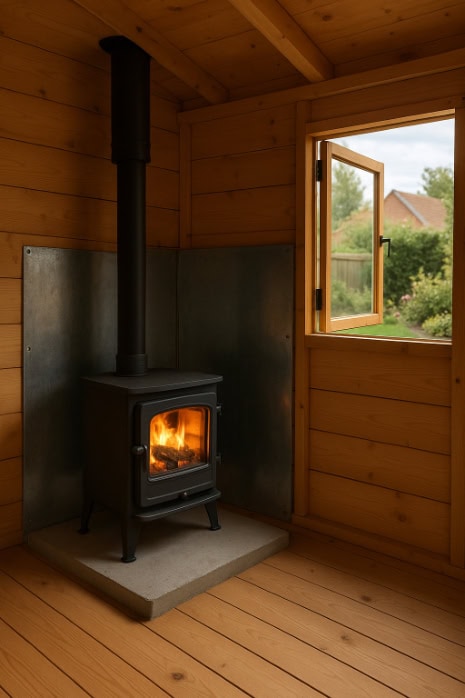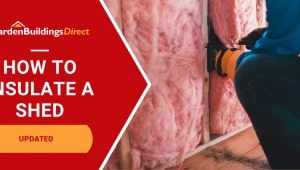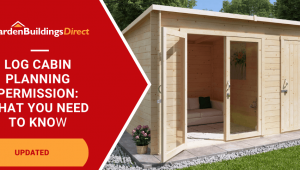Jump to:
There’s nothing wrong with wanting heat in your shed. And installing a wood burner in sheds can make that happen. It’s possible, but only if you set it up the right way. Otherwise, this good idea can turn into a serious problem.
Can You Use a Log Burner in a Wooden Shed?

Yes, you can, but doing this project needs planning. While a wooden shed can handle the heat, you have to be smart about how it moves inside. Moreover, wood and fire don’t mix well unless you give them space and protection.
You’ll need something under the stove that won’t burn; you shouldn’t have it standing directly on timber. Give it something that can take the heat, such as concrete, stone, or thick metal. If sparks drop out when you open the stove door, nothing catches.
The space around the stove matters too. A few heatproof panels or metal sheets, fixed with a small gap behind them, will suffice. That gap lets air move and keeps the wall cool enough.
Then there’s airflow. A burner can’t do much in a sealed shed; it needs fresh air to burn cleanly and a clear path for smoke to leave. A vent, or a small window you can crack open, always does the job. The fire keeps its flame, and the air is easy to breathe.
Safety Risks & How to Mitigate Them
You’re mixing fire and timber, and that always calls for care. The heat spreads, it lingers, and it can build up—keep a good distance on every side and give the wall protection. Something like cement board, corrugated steel, or fire-rated plasterboard.
There’s also the danger of carbon monoxide. It sneaks up when smoke can’t escape or when the fire isn’t burning clean. A vent helps, but a carbon monoxide alarm makes all the difference. That small detector could be the thing that saves you one day!
The flue, which is the pipe that carries smoke and fumes, needs attention too. Give it a regular cleaning to avoid soot buildup and help the burner run better.
Also, keep in mind that fitting a burner can change what your warranty or insurance covers. Some policies view it as a modification and may refuse a claim if an incident occurs. Check the manufacturer’s guide or the model’s specifications before installing anything.
Questions to Ask Yourself Before Shed Wood Burner Installation
Is the shed big enough? If it already feels cramped, a stove will only make it hotter and harder to move around. You need space for the burner, the flue, and enough room to keep clear distances on every side.
Can you run a proper flue? The smoke has to go somewhere safe, either through the roof or the wall. That means cutting, sealing, and fitting an insulated section so the heat doesn’t reach the timber. If you’re not confident doing that, get a qualified installer to handle it. The wall is probably an easier exit point, so that you’re not having to go through both wood and felt.
Do you have the right materials? You’ll need fireproof boards, a solid hearth, and the right pipework. These aren’t things to improvise with whatever’s lying around.
Are you fine with losing your warranty or insurance cover? Adding a burner counts as a modification. It might void your shed’s warranty, and your insurer might not cover any fire damage. It’s not there to put you off; you just need to know where you stand before spending anything.
Can you keep up with maintenance? Wood burners don’t take care of themselves. The flue needs checking, the ash builds up, and seals wear out. If you’re happy to keep an eye on it and do small checks, great! If not, a heater built for sheds might be safer.
Round-up
Installing a wood burner in a shed can be done, but there’s no cutting corners when it comes to fire safety. The stove needs a solid, fireproof base. The pipe should move smoke out through the wall or roof. Plus, leave space around it and let air flow through inside.
If you’re unsure about any step, hire a professional fitter to double-check the setup. Keep a few photos or jot down what you’ve done along the way for proof, just in case. And before you call it finished, fit a smoke alarm and keep a fire extinguisher close by!
Get more tips on keeping yours warm and cosy here: Guide to Garden Room Heating





